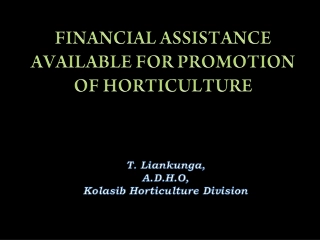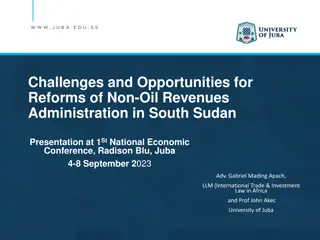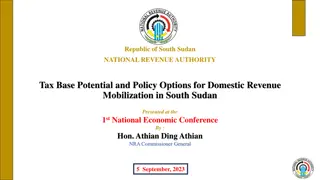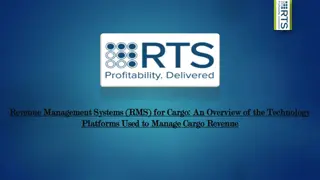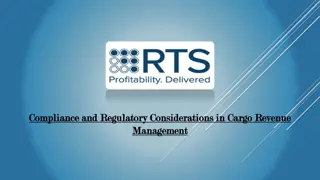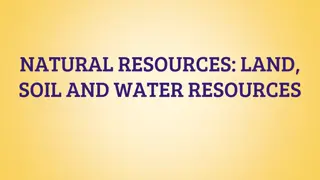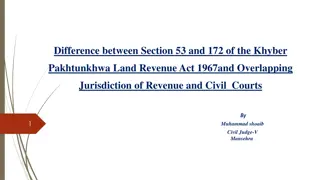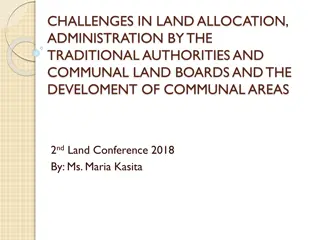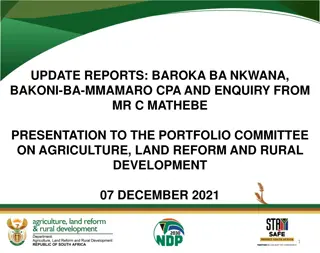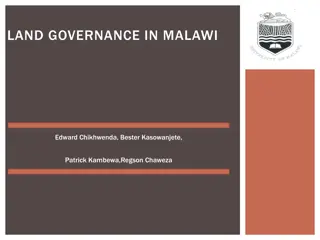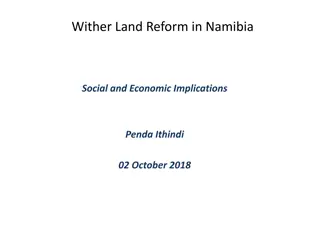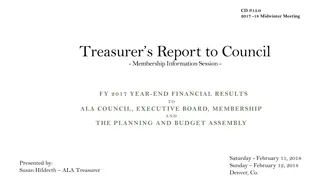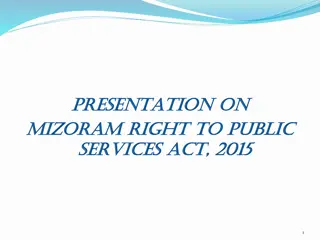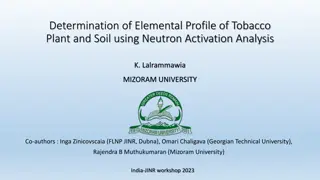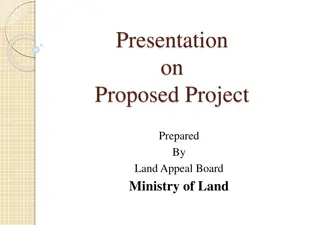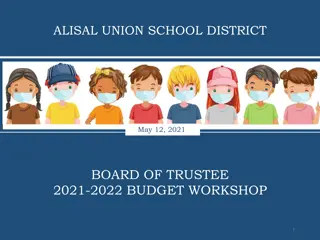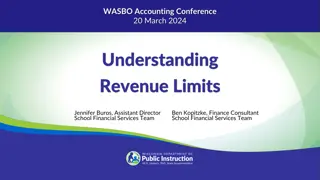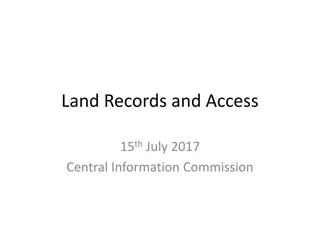Overview of the Mizoram Land Revenue Act, 2013
The Mizoram Land Revenue Act, 2013 replaced several previous regulations and came into effect on June 1, 2013. It establishes authorities for land management, outlines control and powers over land, and provides guidelines for land allotment for specific purposes. The Act designates the Government of Mizoram as the Chief Controlling Authority, with various officials appointed to oversee land-related matters.
Download Presentation

Please find below an Image/Link to download the presentation.
The content on the website is provided AS IS for your information and personal use only. It may not be sold, licensed, or shared on other websites without obtaining consent from the author.If you encounter any issues during the download, it is possible that the publisher has removed the file from their server.
You are allowed to download the files provided on this website for personal or commercial use, subject to the condition that they are used lawfully. All files are the property of their respective owners.
The content on the website is provided AS IS for your information and personal use only. It may not be sold, licensed, or shared on other websites without obtaining consent from the author.
E N D
Presentation Transcript
IMPLEMENTATION OF THE MIZORAM (LAND REVENUE) ACT, 2013, AN OVERVIEW R. Lalramnghaka Director, LR&S ONE-DAY WORKSHOP ON ASSESSMENT & COLLECTION OF TAX, AND STAMPS AND REGISTRATION, AIZAWL. THE 5TH DECEMBER, 2014
1. An Overview of the MLR Act, 2013 Notified on 1st May, 2013, and effective since 1st June, 2013. Repealed: The Assam Land and Revenue Regulation, 1886 The Lushai Hills District (House Site) Act, 1953 The Lushai Hills District (Jhumming) Regulation 1954 The Mizo District (Land and Revenue) Act, 1956 The Mizo District (Agricultural Land) Act, 1963 The Mizo District (Transfer of Land) Act, 1963 The Mizoram (Land Holding and Settlement) Act, 2000 The Mizoram (Taxes on Land, Building and Assessment of Revenue) Act 2004.
2. Authorities on Land (MLR Act, 2013) Government of Mizoram is Chief Controlling Authority. Director, LR&S is Controller of Land Records under the overall supervision of the CCA. Govt. may appoint: Revenue Commissioner, Joint Commissioners (Revenue) and Asst. Commissioners (Revenue); Director, Addl. Director, Jt. Directors, Dy. Directors and Asst. Directors of LR&S; Collector, Addl. Collectors, Deputy Collectors and Assistant Collectors for each District; Settlement Officers, Addl. S.Os, Deputy S.Os and ASOs, at District level; SDO (Revenue) or Deputy Collector and Assistant Collectors at the Sub- Divisional level; Revenue Circle Officer for each Revenue Circle. All Survey Officers are appointed under the Mizoram (Land Survey and Settlement Operation) Act, 2003.
3. Control & Powers over Land - I All lands not allotted to any particular individual or juristic person are the properties of the State Government. Govt. may set apart any land for special purposes of : cultivation of Bamboo, Oil Palm, Tung, contract farming or other commercial farming duly approved by appropriate authority (on lease); development of industries (on lease); Special Housing Projects under CSS or State Scheme(on lease); Compensatory forest; development of village, town or city; any public purpose as may be prescribed (on lease).
4. Control & Powers over Land - II Government may: 1) Allot land for any purpose which is free from all encumbrances to persons who is: A domicile of the State (whose family has been residing in Mizoram since prior to 26th January, 1950), and A Tribal (a person who belongs to one of the Scheduled Tribes for the State of Mizoram and specified as such by an order or orders made by the President of India under Article 342(1) of the Constitution of India in so far as the specification pertains to Mizoram), or a Juristic Person . Subject to appropriate recommendation of (Part-II of MLR Rules, 2013) Site Allotment Advisory Board, and Mizoram Public Investment Board (as prescribed under Part-II of MLR Rules, 2013) [not necessary for area < 5 bighas (6689 sq.m) for individual & juristic persons, or <3 bighas (4013.4 sq.m) for Religious Organisation, or <10 bighas (13378 sq.m) for Govt. Departments] Declare any area as excluded or restricted area [Rule 3(7)]. 2)
5. Control & Powers over Land IIA Restriction of allotment on River banks: No land shall be processed for allotment within the areas of 800 metres measuring from the centre on either side of the following rivers:- (1) Tlawng; (2) Tut; (3) Teirei; (4) Langkaih; (5) Chemlui; (6) Serlui;(7) Tuivawl; (8) Tuirini; (9) Tuirial; (10) Kau; (11) De; (12) Phairuang; (13) Tuiruang; (14) Khawthlangtuipui; (15) Mat; (16) Tuichang (Lunglei District); (17) Tuichang; (18) Tuipui; (19) Tiau; Note: This restriction should not be confused with notified Riverine Reserves under the Forest Act. No mention of Forest or reserve is made in this provision. No rights shall accrue on any land which forms a part of the bed of river, nullah, water-fall, stream or public tank; acquired land; land which has been in common use at any time during 5 years immediately preceeding the commencement of the MLR Act, 2013.
6. Control & Powers over Land - III Village Councils may: 1) Allot land for house sites within Village perimeter where land survey and settlement operations have not yet been done. 2) Allot land for special economic programme like NLUP initially for a period of 1 year. Satisfactory performance of the NLUP beneficiary is necessary for conversion of the allotment into Provisional Pass for NLUP Beneficiary (to be issued by the Government through the DC/ SO/ASO of the District). 3) Allot land to households residing in the village for jhuming for one- year period per allotment (LHDJR, 1954). 4) Be entrusted by the Government with the management of any land or any rights therein for the purposes of supply reserves or any other public utility purposes for the related area, as may be prescribed. Subject to appropriate recommendation of the SAAB, except for Sl. No. (3) above.
7. Control & Powers over Land - IV Land Ceilings: 1) No land shall be allotted to any organisation or institution or individual in the same town/ village if the land already allotted has exceeded 50 bighas or 66,890 square metre. 2) Minimum area of 111.5 sq.m (1200 sq.ft) and a maximum area of 1337.8 sq.m (1 bigha / 14400 sq.ft) for one house site. 3) Allotment of land may be made only on special case and recommendation of the MPIB and public interest. 4) The maximum area for permanent cultivation may exceed 60 bighas or 80,268 square metre per family or per juristic person domiciled in the State only with speaking orders of the Government having regard to the existence of special requirements.
8. Recommending Authorities - I District Advisory Committee (Notification H. 11018/6/2008- REV/Pt dated 15th July, 2013) Page 249-251: Designation Chairman Member Secy Members Aizawl Secretary (Revenue) Director, LR&S DC CCF CEO of AMC / Dir. LAD Director of DM&R JD (TCP) of UD&PA JD(Survey), of LR&S JD of G&MR PD of MIRSAC ADA representative Convenor, INTACH President, LCA Other Districts Deputy Commissioner SO/ASO DFO ASO/ ASO(T) Representative of MIRSAC DUDO of UD&PA DLAO Representative of INTACH Representatives of VCs as invitees
9. Recommending Authorities - II Site Allotment Advisory Board (Notification H. 11018/6/2008-REV/Pt dated 12th July, 2013): 1) Chairman: DC/ representative; SDO(C)/ BDO; VCP; 2) Secretary: SO/ASO; Principal of HSS/ Hm of HS; Hm of HS/MS; 3) Members: 1) LCC/VCP concerned; 2) Representatives of recognised Political Parties; 3) Representative of CYMA/SYMA, Hqrs MUP/ S.Hqrs MUP; 4) Representative of E&F, PWD, PHE & P&E; 5) Representative of LRS Deptt. in areas other than Dist. Hqrs.
10. Recommending Authorities - III Mizoram Public Investment Board: 1) Chairman: Chief Secretary; 2) Secretary: Secretary, LR&S Department; 3) Members: Secretaries/ AS/ JS of 1) Planning Dept., 2) Industries Dept., 3) Horticulture Dept., 4) Agriculture Dept., 5) E&F Dept; 6) UD&PA., 7) MSPCB.
11. Land Disputes Types of disputes: 1) Overlapping of Land Passes: Department has to examine the nature and take action for cancellation/ re-location/ correction of area, depending on the merit of the case. the first Certificate- holder, if in actual and constructive possession of the land, in accordance with the satisfactory fullfilment of the conditions specified in his Land Settlement Certificate, shall become the owner in cases of overlapping of valid Land Passes. 2) Unauthorised occupancy of Govt. (or vacant land): Department is responsible for protection of the said land against such encroachments; and may resort to forced eviction of encroacher (MPGLE Act, 2001). 3) Encroachment of Private lands: Department can verify nature and extent of encroachment, and attempt for amicable settlement. If such efforts failed, the complainant may be furnished with a complete report on verification for settlement of the dispute in appropriate civil court. 4) Dispute over land without supporting documentary proofs also need decision of competent Civil Court.
12. Survey & Demarcation of Land 1) Any survey for allotment or resurvey should contain a clear geographical description (including macro and micro mapping), distinguishable accompanied by boundary measurement of the area duly recorded. 2) NOC signatories should understand the exact purpose of the signature they are to give. 3) Demarcation of Passes for conversion into LSC should be confined to the dimension/ area of the Pass. 4) Cogent and comprehensive report on quality of land-use should invariably accompany the survey report on agricultural lands for conversion into ALSC. boundary pillars description accurate and
13. Land Revenue & Taxes 1) Land revenue means any revenue assessed by the State Government on the land and includes any tax assessed in lieu of land revenue or all moneys described as premium, rent, lease, money, charge, fee, cess or in any other manner, in any enactment, contract or similar instruments [Sec 2 (23)]; 2) All land holders / users of land to pay land revenue, taxes or fees under the Act, unless exempted. 3) Assessment of land revenue, taxes and fees to be done in the manner as provided in the rules made under the Act which includes the actual annual taxes plus arrears (of unpaid due) including the penal interest of 20% on all types of land taxes. The penal interest on tax on leased land specified as 12% may need correction.
14. Assessment of Land Revenue & Taxes 1. Assessment of land revenues and taxes are done at the District level by the District Revenue Offices. The assessment so prepared has to be approved by the Deputy Commissioner who is the District Collector. 2. The assessment of land tax should be made as accurately as possible from the land records in respect of various properties and land holdings mentioned above. For this purpose, the following are necessary:- a) Accurate and updated record of Passes with clear indication of their life-cycles. b) Assessment/ calculation should be computerised (with assessment software) so as to minimise or clerical / human error to zero. c) The whole process of assessment to be closely supervised and monitored by the District Collector.
15. Steps for strengthening land & revenue administration-1 1. Strong and active participation of members of the public through SAAB and Gram Sabha. 2. Establishment and active functioning of the Site Allotment Advisory Board in all the District Hqrs/ Sub-Divisional Hqrs./ Block Hqrs/ Towns and villages, 3. Regularisation of all land holdings under Permits and Passes issued earlier under the repealed Land Laws including Village Council Passes. 4. Strong joint efforts of the LR&S Department and the Town & Country Planning of UD&PA Department for preparation of meaningful Master Plans and Land Use Zoning . 5. Setting up Land Valuation Committees at the levels of Sub-District/ Sub-Division, District and the State, through participatory approach.
16. Steps for strengthening land & revenue administration-2 6. Strengthening the manpower for land survey and Revenue Wing of the Department. 7. Strong information network through internet connectivity from Village State level, 8. Enhancing the skills of Department Officials in IT related matters; 9. Creating awareness among the general public on land laws. 10.Incentive for best performing SAAB, DAC, individuals and NGOs and also the Department Officials. 11.Outsourcing the collection of taxes and land revenue to the VCs/ LCs, with strong monitorin and supervision. 12.Strong political will in the Government.

 undefined
undefined




















